
Growing Our Own Wheat
Hello friends,
I'm a curious person at heart, I love growing new things in the garden, and especially when they're niche plants or crops. Every year I'm always trying a new variety of tomato or basil to see if I can get a crop that works well in our local conditions, and I've also grown linen plants so I can get flax fibre for spinning (but that's a whole other story)...
Back during the great bread flour shortage of 2020 during New Zealand's first Covid 19 lock down, I joked to hubby that we might have to start growing our own wheat and then processing it into flour if we wanted to continue baking our own bread at home. I was only joking of course at the time, but ever since then the idea has been at the back of my mind. Could I possibly successfully grow my own wheat, process it, and then make it into bread?
During the winter months of last year (2022), I finally decided that now was the time to try growing wheat in my vege garden. There's an unspoken rule about wheat locally—you can't grow it successfully in Otago, and especially down in Dunedin. You grow wheat in Canterbury, and oats in Otago (now that gives me another idea...). I chatted with my friends online, and they were doubtful it would work, it's too cold and not sunny enough, but that didn't deter me. Hubby and I live in Mosgiel, which is an inland suburb of Dunedin, and we get long, hot summers compared to suburbs much closer to the sea. I successfully grow limes, lemons, and mandarins outside during the summer, and wheat isn't as fussy as to grow as them.
My first task was researching where I could find wheat seed. I found two small seed merchants in New Zealand who sell it, Kings Seeds and Kōanga Institute. The Kings Seeds wheat was sold in packets for growing wheatgrass, and came in a handy 1 kg packet, so I went with that since I was already buying other seeds from them in my spring seed order.
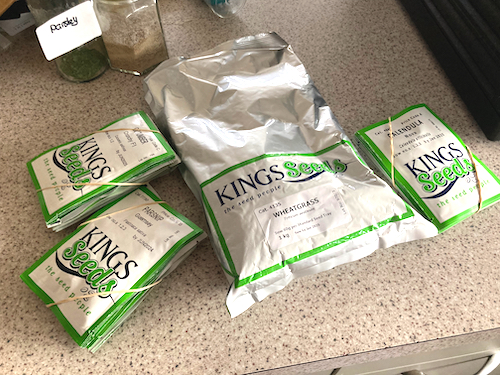
My next task was figuring out when to sow the seed, and I found this wonderful blog post by Epic Gardening detailing everything I needed to know about growing wheat. My plan was to sow a 1 m x 2 m section of vege garden bed in early October, at 25 plants per square foot, as our last frost is usually in late September. That would give the wheat plenty of time to form ripe wheat berries over summer before autumn arrived, as it takes 120 days from seed sowing to harvest. But unfortunately that plan was delayed by two weeks after we got an 8 cm snowfall in early October, followed by a week of frosts.
So the week before Labour Weekend I prepared the soil to a nice and fine tilth, and then sowed my seeds. I diligently placed bird netting on a frame, watered the seeds in, and waited impatiently for them to sprout. What I didn't count on though, was Luna, our neighbor's cat. She had decided that the netting and fame made a nice hammock, and it would be great to sleep on.

While climbing onto, and sleeping on the bird netting she created gaps, and that's how the birds got in. Without me knowing, within half a day, sparrows had eaten most of the wheat seeds I sowed. After much grumping, and completely redesigning the frame and bird netting, I completely bird and cat proofed the second sowing of wheat seed. And this time it worked.
After about a week, the wheat seeds germinated. It was easy to tell the wheat from any weeds, as wheat is a grass plant. The plants grew fast and strong with sunshine and spring rain, and by the time it got to Christmas, the plants themselves were already 80 cm tall, and they'd already set seed heads.
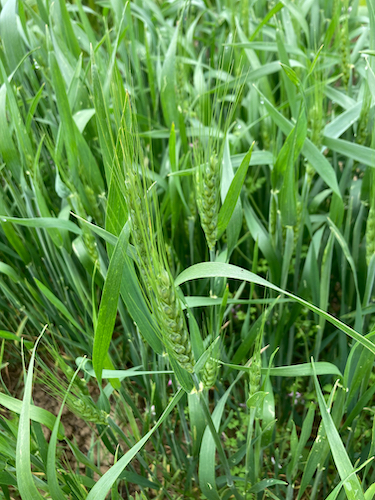
Our past summer was the hottest and driest in years, and I think that helped the wheat ripen quite quickly. The bird netting went back on as the wheat began to turn golden,after I noticed that the sparrows had begun to hang around the wheat again. The tricky part was knowing when to harvest, and I used the Epic Gardening guide to figure out when I was time to cut the stems.
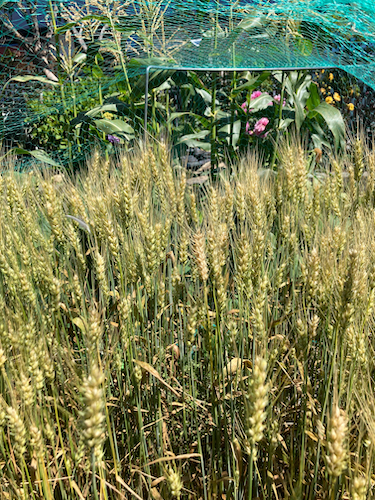
I used a combination of looking at the angle of the heavy seed heads, the hardness of the individual wheat berries when pressed between two fingernails, and also the golden colour of the seed heads to know when it was time to harvest. The wheat wasn't uniformly ready all at the same time, so I selectively cut them on hot summer days in late January, and bundled them up for drying.
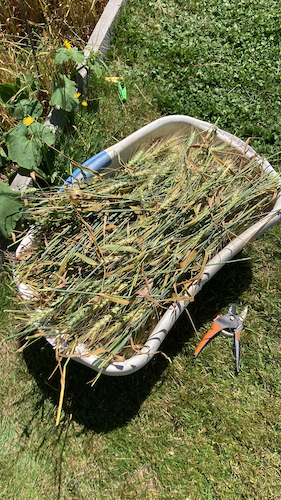
The wheat bundles had to dry in the sun for a week before threshing, but I also needed to keep the sparrows away from the drying grain. After much pondering on how to do this step, I decided on laying out the wheat bundles on the gravel floor of the glasshouse during the day. Every morning I would lay the out the wheat bundles on the glasshouse floor, and then place a mesh screen over the glasshouse door, so there would be good airflow.
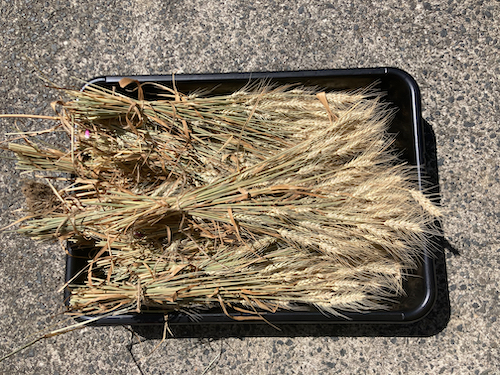
After a week of drying the bundles were bone dry, and some wheat berries had already began popping out of the seed heads. The next step is threshing, followed by winnowing, and I'll share these processes with you in a future blog post.
But what I can conclude from this whole process, is that wheat is indeed an easy to grow crop. It doesn't require any specialised tools, and is well within the abilities of a home gardener. I've also shown that is possible to grow wheat in Otago, and Dunedin, if you live in a warm, sunny suburb away from the sea. I will happily grow wheat again in my garden in the future.
Have a wonderful day
Julie-Ann
Want to discuss my post? Feel free to chat with me on Instagram or Mastodon.




